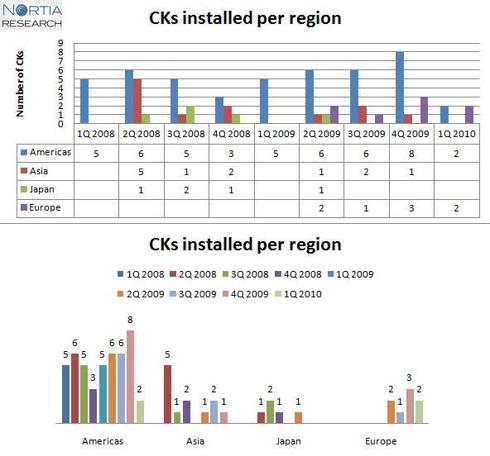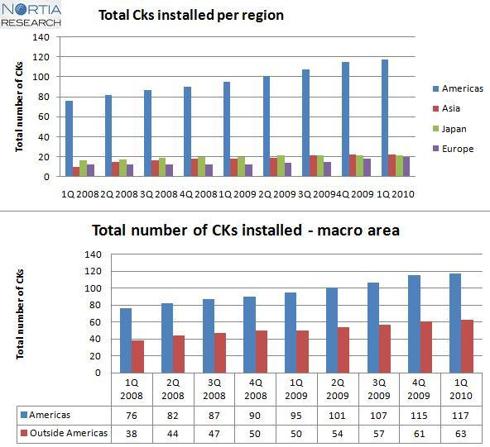Saturday, January 9, 2010
LG Rumor Touch hands-on
LG launched another Rumor set on Sprint yesterday: the LG Rumor Touch. As you all likely sussed from the name, this iteration brings touchscreen -- resistive -- to the mix and it also comes loaded with a pretty stellar keypad. The touchscreen is pretty sharp as well, both with the haptic feedback when using it, response to your finger's pokes, and the quality of the display itself.
Nexus One
>>Synaptics (SYNA), the Santa Clara (Calif.)-based company that specializes in touch-sensitive technology, is supplying several pieces of the touch-enabled screen in the Nexus One, Keller says. Atmel (ATML), a San Jose-based chip company, supplied the chip that controls the touch interface on the Droid.
Friday, January 8, 2010
El Camino Hospital
In January the hospital will complete construction on its new Center for Advanced Radiotherapy and CyberKnife Radiosurgery. The CyberKnife allows physicians to pinpoint solid tumors in the body and use radiation treatment without incisions or anesthesia. Beginning in February the Center will take on patients, and use the facility to teach visiting physicians how to use the CyberKnife and other forms of radiotherapy.
Hospital in Napoli (Italy) thinking about a CyberKnife
>>News from Italy: Naples plans to acq a CK in 2010
Source - Corriere del Mezzogiorno.it
Locali più ampi e accoglienti sono utili, ma non garantiscono cure più moderne ed efficaci.
«Certo. Infatti, punto soprattutto all’adeguamento tecnologico. Da poco abbiamo una modernissima Tac a 64 slide, acquistata attraverso la Soresa, e due mammografi digitali, comprati con la Consip. Entro il 2010 il mio obiettivo è il completamento della radiologia oncologica».
«Con nuovi acceleratori lineari. Attualmente ne abbiamo tre vecchi e uno rinnovato. Non bastano. Inoltre vorrei far arrivare un cyberknife». Un bisturi cibernetico, a cosa serve? «È una nuova attrezzatura che permette di trattare con una mira perfetta le lesioni tumorali altrimenti inoperabili come le neoplasie in alcune zone del cervello. Dovrebbe essere messa in rete con dieci console da installare nelle neurochirurgie della Campania, in modo che si possa programmare ogni intervento prima che sia realmente effettuato » . Costa molto? «Nove milioni circa. Ma si possono ottenere» .
World's first 'haptic' steering wheel controls
In future Kia vehicles, the all-new UVO system will be offered with an innovative touch-sensitive control panel. Advantages over normal buttons include improved response time ensuring sharper and faster reactions to user inputs and enhanced durability with fewer parts.
Looking forward, the use of touch panels with Field Effect ASIC (inner and outer electrodes triggered by finger contact) will enable Kia engineers and designers to take bold steps in rethinking the interior design of Kia models.
II. World's first 'haptic' steering wheel controls
Kia is showcasing the world's first 'haptic' control module built into a car's steering wheel. Touch-sensitive, the haptic control is positioned for easy operation by the driver's thumb and generates reactive feedback vibrations. It features seven modes to control all elements of the vehicle's audio system.
Drivers will quickly learn to monitor the car's systems through touch alone, allowing them to keep their hands on the wheel and their eyes on the road - improving road safety.
RESEARCH ANALYSIS: Review of instrumentation
Visteon executives told us: "A number of automakers are poised to continue their use of touch screens into the foreseeable future. One way that we anticipate touch screen evolving is through the use of supporting technologies like haptics. Haptics can be used to provide touch screens with tactile characteristics of more familiar traditional controls
Thursday, January 7, 2010
The brushed-aluminum LED-lit C9000 is not just the handsomest slender TV at the show, it comes with the most innovative Wi-Fi remote control – one that looks suspiciously like an iPhone and feels suspiciously like a Samsung phone.
Why a Wi-Fi video remote? So you can watch a Blu-ray on your TV while checking out the game in your hand, of course. Maybe you’ve never had that problem, exactly, but this product seems like a step in a new direction, rather than just a “we did it because we could” kind of thing.
The remote connects over your Wi-Fi network to control the TV (also on the Wi-Fi network), much like iTunes Remote works on an iPhone. The screen is vibrant and high-contrast, though it is LCD, not OLED. As you tap buttons on the screen (which I believe is resistive, since Samsung wouldn’t confirm capacitive) you feel a little vibe, haptic feedback that is now common on phones from Samsung and LG. I wish the remote itself felt a little more sturdy; there was a hollowness to it that makes me worry about it sliding off the coffee table. Still, I was impressed by its simple setup and lithe manipulation. It’s like they finally found a good thing to do with all of those feature-phone interfaces nobody needs anymore.
LG Showcases Ultra Thin Mobile PC at CES 2010
Seoul, Jan 7, 2010 - (ACN Newswire) - LG Electronics (LG), a global leader and technology innovator in mobile communications, unveiled its ultra-thin premium mobile PC, LG X300, at CES 2010 in Las Vegas.
The LG X300 offers the sleekest and most stylish look and feel ever for fashion-conscious road warriors. This premium mobile PC tips the scales at a mere 970g and is only 17.6mm thick for the ultimate in portability.
---
from slashgear.com:
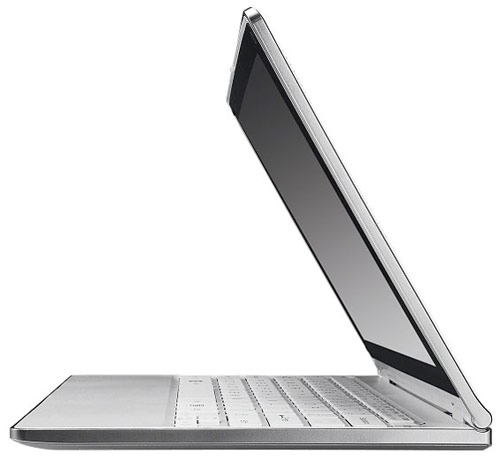
There’s also WiFi, Bluetooth and integrated 3G UMTS modem, and LG bundle two batteries with the ultraportable for lengthy on-the-road use. Apparently you’ll see up to 7hrs use overall, though that’s with both batteries.
There’s also a borderless trackpad with haptic feedback and an auto-sync client that pulls new PIM data from a nearby paired cellphone. LG expect the X300 to arrive on the market starting in February, but they’re yet to confirm pricing.
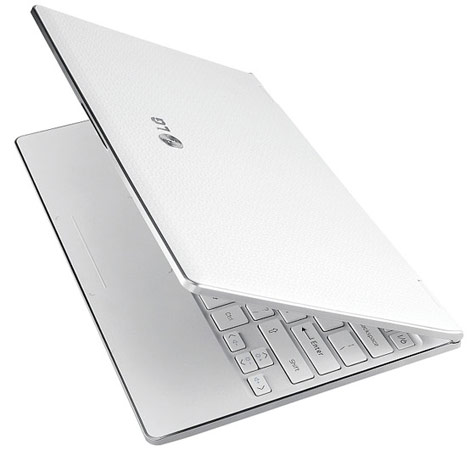
Samsung TL240 camera
Samsung TL240
The TL240 offers up a 3.5 inch touch screen LCD. It shares the same physical dimensions as the CL80, measuring 0.77 inches thick. It combines the Smart Gesture interface with haptic feedback. Soft features abound, including face recognition, panorama shot, Smart Filter effects, and portrait effects such as red-eye fix. These features are all available on the CL80 as well.
Both cameras have been produced through hydroforming, a process that creates a smooth, seamless structure and is utilized by high-end sports car makers. Samsung touts the CL80 and TL240 as the first products in the consumer electronics realm to use this method of production.
Pacinian to Showcase HapticTouch Surface Technology at CES
Pacinian Corporation (Booth 35714, South Hall), an innovator of advanced haptic (tactile) response solutions for improved user experience, will be showcasing new applications of its HapticTouchTM Surface Actuation technology at the International Consumer Electronics Show in Las Vegas, NV, January 7-10. Pacinian will be demonstrating a range of embedded haptic solutions for touch pads, touch screens, keyboards, and other touch surfaces.
Pacinian’s Surface Actuation solution delivers an optimal, nearly instantaneous tactile response at the point of touch interaction. The result is a more intuitive and satisfying user experience. Studies have shown that haptic feedback can improve performance, reduce errors, and enhance user interaction in a wide array of products and applications including gaming, mobile phones, automotive controls, personal computers, and peripherals.
“There has been an incredible response and interest in our innovative Surface Actuation technology from OEMs and touch providers,” said Jim Schlosser, CEO of Pacinian. “CES is a great opportunity for us to demonstrate the value of our high fidelity haptics to market leaders across a broad range of industries.”
Pacinian’s HapticTouch Surface Actuation solution utilizes a proprietary controller design in conjunction with a thin active layer that can be adapted to a broad range of surface materials, sizes, and form factors. This configuration provides direct actuation of the surface, and does not require the complex mechanical integration of motors or solenoids of vibration-based haptic solutions. There are several advantages to the HapticTouch solution over other haptic technologies:
- High Fidelity – The high bandwidth planar motion of surface actuation enables the generation of precision feedback across a broad frequency range.
- Fast Response Time - Surface response is virtually instantaneous, ensuring a compelling experience no matter how fast the interaction.
- Scalability - HapticTouch technology can be applied to small and large surfaces, ranging from mobile handsets to eBooks, Netbooks, Tablet and Notebook PCs, Point of Sale, and casino gaming.
- Thin - The low profile design is the thinnest haptic solution available.
- Ease of Integration - The active surfaces can be integrated into most existing industrial designs, resulting in minimal changes and fast time to market.
- Power Efficient - HapticTouch systems sip power with minimal impact to battery life.
- Reliable - Using well-understood materials and processes, manufacturers can design systems for long life, even in the most hostile environments.
- Design Freedom - HapticTouch technology enables next generation designs that exceed user expectations. Keyboard/keypads can be credit card thin, easily cleanable and fully rugged. Touch screens and touch pads can deliver intuitive tactile feedback for a satisfying user experience. Appliances, automobiles, and industrial control systems can implement reliable, digital-sensing technology without sacrificing usability.
Pacinian Corporation
Michael Levin, +1 650-450-3385
Vice President, Business Development
mlevin@pacinian.com
Dell tablet
Details are scarce, but the 5-inch device would be smaller than rival ideas coming from HP and (presumably) Apple. Describes as a "tablet concept," there's no guarantee the product would ever reach the public in its current form.
We had a chance to check out the device behind closed doors after the press conference, and even hold it in our hands for a few minutes.
...
Haptic vibration kicked in when we tried launching a few feature buttons.
Antitrust Division's review of the Equinix - Switch and Data Merger
>>On January 6, 2010, Equinix received a Request for Additional Information (commonly referred to as a "second request") from the Antitrust Division in connection with the Antitrust Division's review of the Merger. This second request extends the waiting period imposed by the HSR Act until 30 days after Equinix has substantially complied with the second request unless that period is extended voluntarily by Equinix or terminated sooner by the Antitrust Division. Equinix intends to respond promptly to the second request and now expects the Merger to close in the second quarter of 2010.
A couple of articles about the news, from Telecom Rumblings and Data Center Knowledge:
Equinix, Switch and Data Facing Anti-trust Scrutiny
Switch & Data Sale Slowed by Regulators
MSI mini-laptop prototype has haptics
>>MSI mini-laptop prototype has haptics
MSI introduces dual-screen netbook/eBook reader running Windows 7
Both of the screens are 10 inch multitouch displays that interact the way two monitors would on a dual-display setup. The on-screen keyboard actually provides a bit of tactile feedback using a haptic-display or similar technology.
News from Korea: Clinical Results of Cyberknife® Radiosurgery for Spinal Metastases
Journal of Korean Neurosurgical Society
Volume 46, Number 6 (12/2009)
Clinical Results of Cyberknife® Radiosurgery for Spinal Metastases
Ung-Kyu Chang, MD, PhD, Sang Min Youn, MD, Sukh Que Park, MD, PhD and Chang Hun Rhee, MD, PhD
Department of Neurosurgery, Korea Cancer Center Hospital, Korea Institute of Radiological and Medical Science, Seoul, Korea
OBJECTIVE : Primary treatment of spinal metastasis has been external beam radiotherapy. Recent advance of technology enables radiosurgery to be extended to extracranial lesions. The purpose of this study was to determine the clinical effectiveness and safety of stereotactic radiosurgery using Cyberknife in spinal metastasis.
METHODS : From June, 2002 to December, 2007, 129 patients with 167 spinal metastases were treated with Cyberknife. Most of the patients (94%) presented with pain and nine patients suffered from motor deficits. Twelve patients were asymptomatic. Fifty-three patients (32%) had previous radiation therapy. Using Cyberknife, 16-39 Gy in 1-5 fractions were delivered to spinal metastatic lesions. Radiation dose was not different regarding the tumor pathology or tumor volume.
RESULTS : After six months follow-up, patient evaluation was possible in 108 lesions. Among them, significant pain relief was seen in 98 lesions (91%). Radiological data were obtained in 83 lesions. The mass size was decreased or stable in 75 lesions and increased in eight lesions. Radiological control failure cases were hepatocellular carcinoma (5 cases), lung cancer (1 case), breast cancer (1 case) and renal cell carcinoma (1 case). Treatment-related radiation injury was not detected.
CONCLUSION : Cyberknife radiosurgery is clinically effective and safe for spinal metastases. It is true even in previously irradiated patients. Compared to conventional radiation therapy, Cyberknife shows higher pain control rate and its treatment process is more convenient for patients. Thus, it can be regarded as a primary treatment modality for spinal metastases.
First US Government owned CK installed in Houston
>>First US Government owned CK installed in Houston
First US Government owned CK has been installed at the Michael E. DeBakey VA Medical Center in Houston, Texas and will be operational by April 2010.
Wednesday, January 6, 2010
Equinix Inc. (EQIX) Expected To Do Well
Equinix Inc. will be benefited by the positive industrial scenario. Equinix Inc. is a geographically diversified firm and has an equally diversified customer base. It also has strong financials to carry out continued investment. Due to these positive points, BoA has raised their forward looking MRR per cabinet expectations by 0.5% through 2012. Bank of America has revised its price target for Equinix Inc. from $110 to $130, which is 11.4X multiple of E2011 EBITDA.
Tuesday, January 5, 2010
EVIDENCE.COM™
EVIDENCE.COM™ is a virtual evidence warehouse, offering digital storage in a highly secure, easily accessible environment. From EVIDENCE.COM™, both agencies and legal professionals may quickly access key evidence data without the difficult and sometimes-impossible inventory searches common to yesterday's storage methods.
Unlock the Knowledge Hiding in Your Evidence
EVIDENCE.COM™ is a full featured system designed around easy-to-use dashboards that turn geospatial multi-media evidence, such as GPS tagged video, into visual dashboards and tactical maps with full click-through to underlying video data. See the big picture with EVIDENCE.COM™.
See All Angles with Perspective Hopping™
EVIDENCE.COM™ automatically links together AXON™ videos from the same scene. Revolutionary Perspective Hopping technology allows you to jump between videos from different AXON™ units to see the visual perspectives of each officer on scene as the events happen.
Search and Collaborate Securely with Virtual Fusion Centers
EVIDENCE.COM™ gives you full control over your data security. Advanced features like Virtual Fusion Centers allow agencies to create secure groups to seamlessly share evidence and collaborate on cases.
---
>>The ambition is breathtaking: Using tools from Taser International Inc. (primarily a tiny camera worn on a police officer’s head), networking pipes from Cisco Systems Inc. (Nasdaq: CSCO), and a private cloud built by Equinix Inc. (Nasdaq: EQIX), Evidence.com means to do nothing less than revolutionize street law enforcement by capturing and saving every important moment in a cop’s day.
...
That prompts another question: Can the system scale to meet the immense data throughput needs every additional officer brings? (Smith estimates each officer generates 1 gigabyte per hour on duty.) Vincent DiMemmo, general manager, Global Cloud Computing, for Equinix, says Evidence.com was created with scalability in mind: “We know we can grow this as required.”Bottom line: It’s a smart move, particularly for Cisco and Equinix, both of which may be riding a powerful wave that wins them roles in bigger cloud rollouts in 2010.
Accuray's missing accuracy with backlog
In his article “Notes from Accuray Annual Shareholder Meeting (2009)” Matthew Rafat recently shared with us, on Seeking Alpha, what happened during that specific event and also gave us a very accurate presentation of Accuray (ARAY), its revolutionary technology and some of the problems surrounding its stock performance.
We invite those who still haven't read the article to go through it, including the comment section.
With our small notes, we will only try to add a few considerations mostly related to the performance of the Company in terms of product sales and communication to the market.
A quick look at Accuray's stock price since the IPO (which was made in February 2007, at $18, with the stock jumping around $30 soon after) says a lot about the trend that the shares have experienced recently (chart from Google, click to enlarge):
While it is generally impossible to find a single fact explaining a Company's poor performance, we will make an effort to select the few reasons that do represent, in our opinion, the main causes for this continuous slide.
Since its first filings, Accuray has always mentioned the existence of a large backlog. For example, here is what the Company wrote in its Form 10-Q for the Quarter Ended December 31, 2006
- As of December 31, 2006, our backlog was approximately $327.9 million.
Backlog was defined as the sum of two components: deferred revenue and future payments that Accuray's customers were contractually committed to make, but which were not yet received. Basically, backlog included non-contingent contractual commitments from CyberKnife system purchase agreements, service plans and minimum payment requirements associated with Accuray's shared ownership programs.
A large part of it ($193.2 million) was represented, at that time, by CyberKnife system sales, with the rest belonging to the mentioned service plans and shared ownership programs.
Assuming a selling price of about $4 million, and using simple (simplistic?) math, the average investor would have probably speculated that Accuray was holding orders for about 50 CyberKnife systems as of December 2006. If we look at the average product installations in a year, we get to a number closer to 30 per year, in 2006, 2007 and even 2008. Quite disappointing, given the expectations created by the large backlog number, and the fact that the Company claimed new system sales every quarter (a similar comparison could be run for revenues, but we prefer to keep it simple talking about system sales/installations, to avoid revenue recognitions problems caused by different accounting rules used by the Company).
To make it even more complicated, in the past Accuray used to report, in addition to non-contingent backlog (i.e. for which all contractual obligations had been satisfied, like the one we just mentioned for December 2006), also what was mentioned as “contingent”. The contingent backlog also did contribute to inflating revenue expectations, as this number sounded like “potential CyberKnife sales” just waiting for authorization/financing. This also consisted of several million dollars, each quarter.
Beginning with the first quarter of fiscal 2010 (July-September 2009), Accuray has started reporting only non-contingent orders as backlog, using a refined criteria.
However, while the Company had stated in its 4Q 2009 P/R that “Of the contracts signed by June 27, 2009, non-contingent contracts, for which all contractual obligations have been satisfied, accounted for approximately $407 million or 73 percent of total backlog reported for the fourth quarter of fiscal 2009”, the same backlog, using a new, more restrictive definition, was quantified in the 1Q 2010 P/R in a completely different way: “ Applying these refined criteria to the backlog as of June 30, 2009 would yield a backlog of $282 million. “ Over $120 million have basically been canceled from backlog due to a different, more selective approach to sales reports.
Unsurprisingly, Accuray is facing a class action alleging that the Company
- misrepresented and failed to disclose material information concerning the quality and realistic likelihood of fulfillment of contracts in Accuray’s “backlog,” a figure representing the direct revenue that Accuray expects to receive from the sale and servicing of the CyberKnife system (more details about the class action are available at this link)
and analysts were quite upset, with Oppenheimer's Amit Hazan writing: “Are You Kidding Me?” as the main headline to comment 1Q 2010 results and the backlog reinstatement, which in his opinion meant that the product segment of that backlog was restated down by about 60% (there are now about 25 CyberKnife systems in the backlog reported with the new criteria as of 1Q 2010).
To resume it, the mix of high market expectations (artificially created by the presumption of future system sales justified by the Company's inflated backlog comments), coupled with relatively flat sales, and the surrounding economy worsening in recent times, may, in our opinion, fully explain why the stock has recently been on a continuous slide, and why there is a general perception that management may be held responsible for the Company's weak performance.
Accuray's poor share price can also partially be explained, in 2009, by the decision of one of its largest shareholders, President International Investment Holdings Ltd., to liquidate part of its initial investment (here is its most recent sale), probably to finance other investments in Asia (the company is located in Taiwan). A summary of President International Investment Holdings trading history is available at this link.
Matthew's articles also mentioned the accounting reason why the Company will keep recognizing some deferred revenues, linked to old contracts written before 2005, over the next two years. Without getting too deeply into this accounting matter, we also believe that this change in the way the Company recognized revenues had the effect to make it more difficult, for the average investor, to track the underlining performance, as it is more complicated to understand Accuray's cash flow dynamics, for example, and comparing revenues between different periods (using different accounting rules) may sound like an apple to orange comparison. As a further example, future revenues numbers will see a very limited impact from legacy Platinum contracts and may look weak, in comparison, even if the Company keeps growing system sales.
For this reason, we suggest to simplify the approach and just look to CyberKnife installations as the only way to track Accuray's performance and understand if an inflection point has been reached by the Company.
Here is a simple chart resuming some numbers: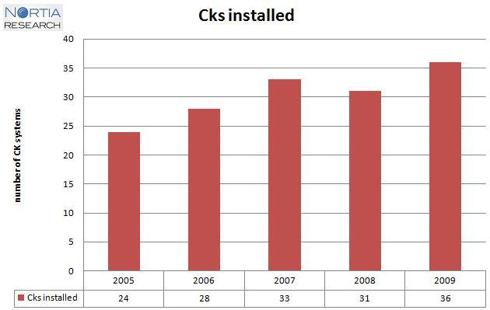
Accuray has basically been selling about 30 systems per year since 2006. In spite of the surrounding weak economy, 2009 was a record year for the Company in terms of CyberKnife sales, while 2008 had seen a slight decline compared with 2007. These basic numbers do also explain why the Company is not perceived by the stock market as a “growing story” - as flat would probably describe it better, so far.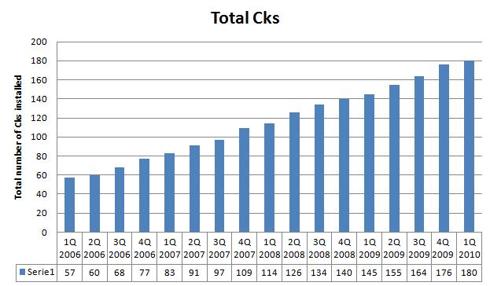
In terms of absolute performance, however, it is interesting that Accuray can now count on 180 CyberKnife systems installed in the world, with new markets recently opened. It is always quite difficult to “break the ice” for a new technology, as shown, for example, by the fact that sales in Canada were possible since August 2006, but just recently the first hospital in Montréal introduced a CyberKnife, with other locations probably following soon (Ottawa and Hamilton, Ontario) .
The more systems installed, the more patients' clinical data Accuray will acquire (essential to prove if the technology is effective compared to today's standards of cure, and further increase demand for new CyberKnife systems). Time should be on the Company's side, assuming the technology is really disruptive (big IF, of course).
While management has messed it up with the backlog, we believe that visibility, in this kind of business, is relatively good.
Given the fact that a customer must construct or renovate a facility to house a CyberKnife (as special radiation shielding are required), when you think about it, the Company knows reasonably well in advance how many systems will be, most probably, installed in the next few months. Although we understand that slight construction delays might move an installation to a subsequent quarter, we do not see as impossible to give out, for example, a realist guidance for installations forecasted in the following 6 months, rather than the useless, so far, backlog revenue numbers.
How can a single shareholder try to keep track of the Company's development, absent some help from Accuray itself?
As we may notice from this chart, sales are, in absolute terms, relatively low, with installations going from 3 to 12 per quarter.
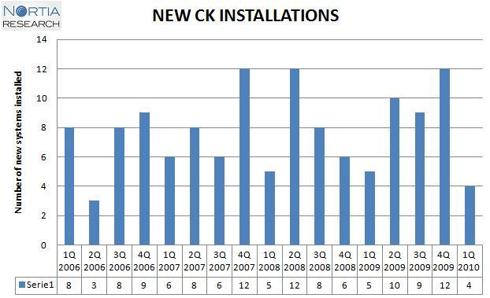
Given the fact that, very often, hospitals or institutions start “advertising” in several ways their intention/decision to install a CyberKnife (because they need to start raising funds or to ask for a permission/certificate of need, or look for the professionals to run the facility, or to promote their presence in advance to the official opening, etc. etc.), it is relatively easy to track the Internet and find out about new installations.
For example, yyy60, on the Investor village Message Board, does a fantastic job following and sharing all these information. His posts can be found at this link.
While we know that we haven't covered many interesting aspects of the Company (which we might leave for another article), we hope we have pointed out a few facts that most probably caused the recent stock price weak performance: Accuray needs to re-build credibility with the investing community, and, obviously, to accelerate its CyberKnife systems sales trend to reverse its fortune. The Company still holds a tremendous potential.
To better track future developments, also in terms of markets, here are a few more data about the Company's recent performance:






